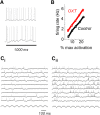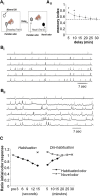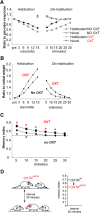A Computational Model of Oxytocin Modulation of Olfactory Recognition Memory
- PMID: 31399493
- PMCID: PMC6727149
- DOI: 10.1523/ENEURO.0201-19.2019
A Computational Model of Oxytocin Modulation of Olfactory Recognition Memory
Abstract
Social recognition in mammals depends on complex interactions between sensory and other brain areas as well as modulatory inputs by specific neuropeptides such as oxytocin (OXT). Social recognition memory specifically has been shown to depend among others on olfactory processing, and can be probed using methods similar to those used when probing non-social odor memory. We here use a computational model of two interconnected olfactory networks in the mouse, the olfactory bulb (OB) and anterior olfactory nucleus, to propose a mechanism for olfactory short-term recognition memory and its modulation in social situations. Based on previous experiments, we propose one early locus for memory to be the OB. During social encounters in mice, pyramidal cells in the anterior olfactory nucleus, themselves driven by olfactory input, are rendered more excitable by OXT release, resulting in stronger feedback to OB local interneurons. This additional input to the OB creates stronger dynamics and improves signal-to-noise ratio of odor responses in the OB proper. As a consequence, mouse social olfactory memories are more strongly encoded and their duration is modulated.
Keywords: anterior olfactory nucleus; computation; olfaction; oxytocin; plasticity; social odors.
Copyright © 2019 Linster and Kelsch.
Figures





Similar articles
-
Vasopressin, oxytocin, and social odor recognition.Horm Behav. 2012 Mar;61(3):259-65. doi: 10.1016/j.yhbeh.2011.08.014. Epub 2011 Aug 30. Horm Behav. 2012. PMID: 21920364 Review.
-
GABAB Receptors Tune Cortical Feedback to the Olfactory Bulb.J Neurosci. 2016 Aug 10;36(32):8289-304. doi: 10.1523/JNEUROSCI.3823-15.2016. J Neurosci. 2016. PMID: 27511004 Free PMC article.
-
Oxytocin Enhances Social Recognition by Modulating Cortical Control of Early Olfactory Processing.Neuron. 2016 May 4;90(3):609-21. doi: 10.1016/j.neuron.2016.03.033. Epub 2016 Apr 21. Neuron. 2016. PMID: 27112498 Free PMC article.
-
Chronic chemogenetic stimulation of the anterior olfactory nucleus reduces newborn neuron survival in the adult mouse olfactory bulb.J Neurochem. 2021 Sep;158(5):1186-1198. doi: 10.1111/jnc.15486. Epub 2021 Aug 16. J Neurochem. 2021. PMID: 34338310
-
Olfactory Circuitry and Behavioral Decisions.Annu Rev Physiol. 2021 Feb 10;83:231-256. doi: 10.1146/annurev-physiol-031820-092824. Epub 2020 Nov 23. Annu Rev Physiol. 2021. PMID: 33228453 Review.
Cited by
-
Midbrain circuits of novelty processing.Neurobiol Learn Mem. 2020 Dec;176:107323. doi: 10.1016/j.nlm.2020.107323. Epub 2020 Oct 11. Neurobiol Learn Mem. 2020. PMID: 33053429 Free PMC article. Review.
-
Genetic influences of autism candidate genes on circuit wiring and olfactory decoding.Cell Tissue Res. 2021 Jan;383(1):581-595. doi: 10.1007/s00441-020-03390-8. Epub 2021 Jan 30. Cell Tissue Res. 2021. PMID: 33515293 Free PMC article. Review.
-
Extrinsic neuromodulation in the rodent olfactory bulb.Cell Tissue Res. 2021 Jan;383(1):507-524. doi: 10.1007/s00441-020-03365-9. Epub 2020 Dec 23. Cell Tissue Res. 2021. PMID: 33355709 Free PMC article. Review.
-
Context-dependent odor learning requires the anterior olfactory nucleus.Behav Neurosci. 2020 Aug;134(4):332-343. doi: 10.1037/bne0000371. Epub 2020 May 7. Behav Neurosci. 2020. PMID: 32378908 Free PMC article.
-
Reinforced Odor Representations in the Anterior Olfactory Nucleus Can Serve as Memory Traces for Conspecifics.eNeuro. 2025 Jul 28;12(7):ENEURO.0143-25.2025. doi: 10.1523/ENEURO.0143-25.2025. Print 2025 Jul. eNeuro. 2025. PMID: 40664512 Free PMC article.
References
Publication types
MeSH terms
Substances
LinkOut - more resources
Full Text Sources
Molecular Biology Databases
Research Materials
Miscellaneous
